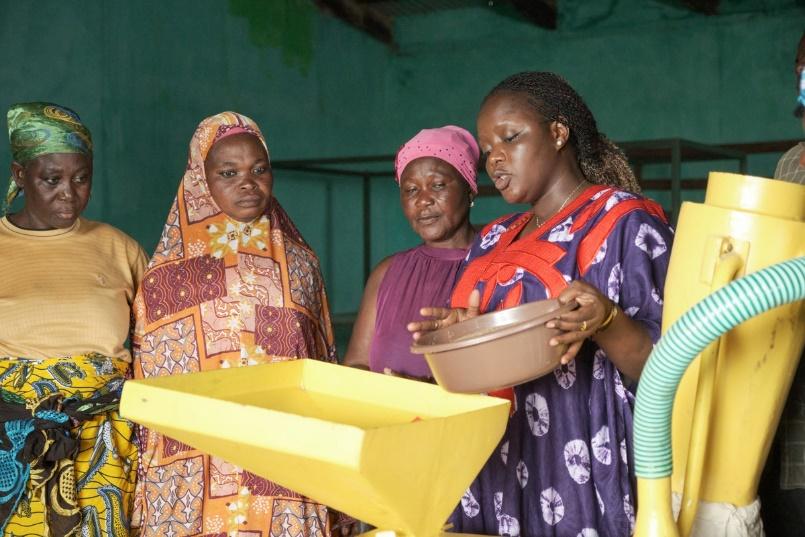FAO Feature for World Food Day
The ancient grain and the African chef empowering women farmers in Ghana
Three young siblings from a small town in northeastern Ghana wake up one morning delighted by the fonio porridge that awaits them that day. As the children enjoy their breakfast, Christabel Kwasi, the 29-year-old farmer and mother of three, is pleased to see the fruits of her labour in the smiles of her children. She is also quietly grateful that she had enough harvest to feed her family of five.
Fonio, an ancient indigenous West African cereal, which has traditionally been cultivated by women in northern Ghana, is a staple food for Christabel and many families in the district of Chereponi. Fonio, once boiled, resembles couscous and can be consumed as such or made into a porridge. It can even be turned into flour for baking. It is a versatile crop that generations have relied on, for both food and livelihoods.
“I realized that my family likes fonio, and they depend on fonio more than any other food crop,” says Christabel. “Our grandparents were telling us, [in] our forefather’s time there was a lot of hunger. So fonio is the type [where] if you don’t even have money to buy chemicals [fertilisers], you can still farm it, feed on it.”
As she regales the festivities that surround the harvest and consumption of this nutritious millet, Christabel expresses her eagerness to teach people across Ghana how they can also grow fonio and prepare dishes with it.
With fonio, “I will not teach people to have food for one day. But I will teach them to have food always,” she says.
Fonio for all year-round
It wasn’t until a year ago that Christabel learned she could grow fonio during the dry season as well. Previously, she thought she had to wait for periods of rainfall and solely rely on the arduous traditional methods of cultivation, which often left her family with little to no harvest during the dry season. In Ghana, the limited resources for rural farmers and the manual methods of post-harvest handling and processing, mostly undertaken by women, is an exhaustive process impacting their yields.
However, a project recently implemented by the Food and Agriculture Organization of the United Nations (FAO), in collaboration with Chef Fatmata Binta, renowned in the culinary world for bringing African gastronomy to the global scene, has given Christabel and other farmers the knowledge that they can rely on this crop year-round. Together with the Ghana’s Ministry of Food and Agriculture, the project aims to support women fonio producers in Ghana to enhance their cultivation skills and boost productivity and income.
“The good collaboration between FAO, Chef Binta, and Ghana’s Ministry of Food and Agriculture has shown how fonio is an effective resilience-building measure particularly for communities affected by prolonged dry spells, such as we’re seeing now in northern Ghana. By supporting better production of fonio, communities can access a sustainable, climate-resilient crop that can improve food security and provide new livelihood opportunities,” said Priya Gujadhur, the FAO Representative ad interim in Ghana.
The project is a further extension of FAO and Chef Binta’s work in advocating for the potential of fonio as a nutritious ingredient and a livelihood opportunity for women farmers.
“We talk about hunger; we talk about climate change. And I see fonio as a solution, especially in Africa,” Chef Binta says. “The fact that you are able to grow something that is so low maintenance; they will be able to feed their families, put their kids through school and have enough money to support themselves,” she added.
Investing in women fonio farmers
Through training sessions on better production and post-harvest techniques, women fonio producers learned to increase their yields and properly store their grains to prevent food loss.
Specific sessions on planting methods, fertilisation and nutrient management were dedicated to helping the women grow more. “We have gotten to know that it’s not only broadcasting [a method of farming where you scatter seeds over the soil] that you can farm your fonio. You can farm it in a line [planting in rows],” Christabel says, reflecting on what she learned. Planting in rows requires less seeds and the uniformity makes cultivating practices more effective.
The traditional method of fonio processing, the biggest challenge for the women, requires they pound the grains by hand for threshing, winnowing and then also manually drying. To minimize this time-consuming and labour-intensive process, Chef Binta is providing processing machines, and with training on how to operate the machinery from an agronomist, women fonio producers will be able to process their fonio with better quality and greater quantities.
Subsequently, the knowledge and skills the women learned about proper bagging, packing and control of pests will greatly improve storage practices and reduce food loss during this stage. This way, they can properly store their grains to consume or sell later in the year.
Another objective of the project is to sensitize the public on fonio consumption and spread the benefits of fonio to communities beyond Chereponi.
Chef Binta, with her expertise on fonio, is building trust and showcasing this potential. She is currently working with the women fonio producers to build a cooperative where they can have the space to collaborate and celebrate its production.
By unlocking the potential of this grain and investing in the women who produce them, families can remain food secure and improve their livelihoods for generations.
The Right to Food is a universal human right. This year, we are advocating for that and more. The foods that feed us need to take into account diversity, nutrition, affordability, accessibility as well as safety and sustainability. Over 2.8 billion people are still unable to afford a healthy diet. As we mark World Food Day on October 16, FAO is emphasizing that the right to foods which meet all of these pillars, is crucial for a better life and a better future for all.

